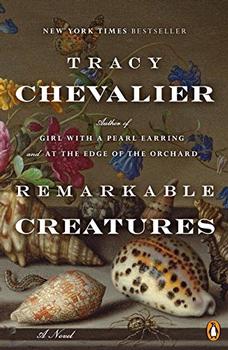Summary | Excerpt | Reading Guide | Reviews | Beyond the Book | Read-Alikes | Genres & Themes | Author Bio

This article relates to Remarkable Creatures
he cliffs and beaches of Lyme Regis, in Dorset on the south coast of England, are fertile hunting grounds for creatures who lived in what were equatorial seas in the early Jurassic period, around 190 million years ago. Here is a look at some of the fossil types Mary Anning discovers in Remarkable Creatures:
 Ammonites are distant relatives of modern-day cephalopods such as octopus, squid, or chambered nautilus, which they most resemble because of their whorled shell. They grew quickly over a life-span of roughly two years. Ammonite fossils from Lyme Regis can range from the size of a fingertip to about 2 feet in diameter.
Ammonites are distant relatives of modern-day cephalopods such as octopus, squid, or chambered nautilus, which they most resemble because of their whorled shell. They grew quickly over a life-span of roughly two years. Ammonite fossils from Lyme Regis can range from the size of a fingertip to about 2 feet in diameter.  The name "ammonite" comes from Greek version of the Egyptian god Ammon, who is often depicted with ribbed ram's horns.
The name "ammonite" comes from Greek version of the Egyptian god Ammon, who is often depicted with ribbed ram's horns.
 Sea lilies resemble plants in their long stems and feathery "blossoms", but in fact they are a class of marine animal known as a "stalked crinoid." Sea lillies attached themselves to the sea floor and filtered food from the water with mobile feeding arms. Descendants of sea lilies are still live today, and are known as "feather stars." Other relations include sea stars, sea urchins, and sand dollars.
Sea lilies resemble plants in their long stems and feathery "blossoms", but in fact they are a class of marine animal known as a "stalked crinoid." Sea lillies attached themselves to the sea floor and filtered food from the water with mobile feeding arms. Descendants of sea lilies are still live today, and are known as "feather stars." Other relations include sea stars, sea urchins, and sand dollars.
 Mary Anning and her brother Joseph found the complete skeleton of a Jurassic-era ichthyosaur in 1812; the creature (which was thought to resemble a crocodile) didn't receive its current scientific name until 1817. An ichthyosaur is a dolphin-shaped animal descended not from fish, but from land reptiles that returned to the sea and adapted to marine life. Unlike other air-breathing aquatic reptiles, ichthyosaurs did not have to return to land to lay eggs, but bore live young. The name ichthyosaur means "fish lizard."
Mary Anning and her brother Joseph found the complete skeleton of a Jurassic-era ichthyosaur in 1812; the creature (which was thought to resemble a crocodile) didn't receive its current scientific name until 1817. An ichthyosaur is a dolphin-shaped animal descended not from fish, but from land reptiles that returned to the sea and adapted to marine life. Unlike other air-breathing aquatic reptiles, ichthyosaurs did not have to return to land to lay eggs, but bore live young. The name ichthyosaur means "fish lizard."
 The plesiosaur was another aquatic reptile, with paddle-like flippers, a long, flexible neck, and a narrow head. Some Loch Ness monster enthusiasts surmise that Nessie could be a plesiosaur.
The plesiosaur was another aquatic reptile, with paddle-like flippers, a long, flexible neck, and a narrow head. Some Loch Ness monster enthusiasts surmise that Nessie could be a plesiosaur.
Other fossils of note: Mary Anning went on to discover the first English pterodactyl fossil (Dimorphodon), an important fish called Squaloraja, and several interesting belemnites (squid-like cephalopods) with ink sacs still intact.
Visit Tracy Chevalier's fossil gallery.
Filed under Medicine, Science and Tech
![]() This "beyond the book article" relates to Remarkable Creatures. It originally ran in February 2010 and has been updated for the
October 2010 paperback edition.
Go to magazine.
This "beyond the book article" relates to Remarkable Creatures. It originally ran in February 2010 and has been updated for the
October 2010 paperback edition.
Go to magazine.
Your guide toexceptional books
BookBrowse seeks out and recommends the best in contemporary fiction and nonfiction—books that not only engage and entertain but also deepen our understanding of ourselves and the world around us.